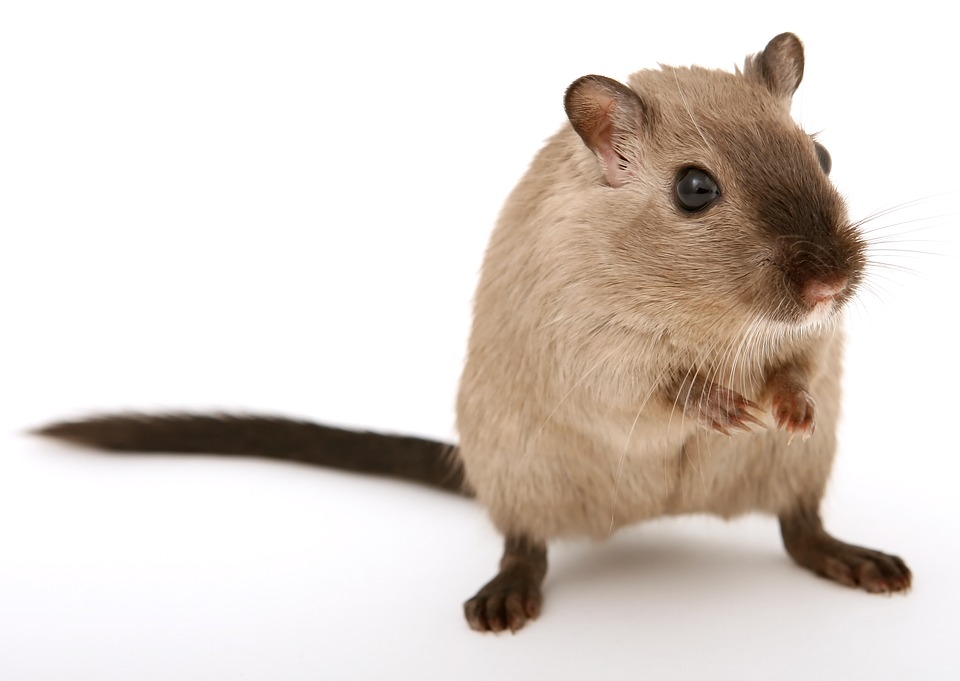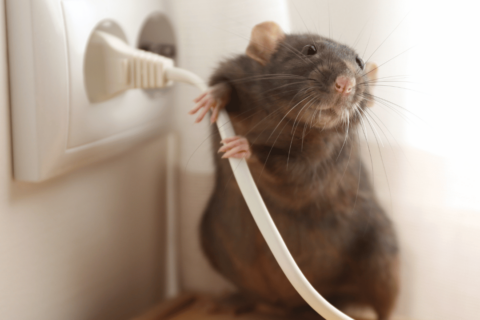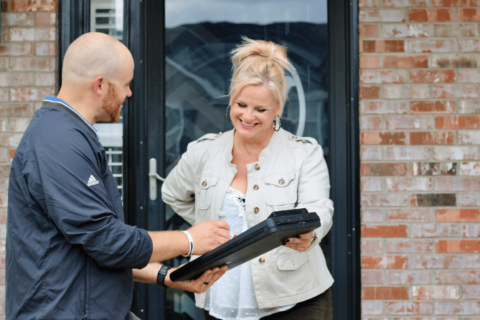Controlling House Mice

The house mouse (Mus musculus) is one of the most troublesome and economically important rodents in the United States. House mice live and thrive in a variety of locations. They are found in and around homes and farms, as well as in open fields and agricultural fields. House mice consume and contaminate food for human and livestock consumption. They may cause damage to structures and property, and they may also transmit diseases such as salmonellosis (food poisoning) and swine dysentery.
Recognizing mouse infestations
Droppings, fresh gnawing and tracks are signs of mouse activity. Mouse nests, made from fine shredded paper or other fibrous material, are often found in sheltered locations. House mice have a characteristic musky odor that identifies their presence. Mice occasionally are seen during daylight hours, but they are most active at night.
House mouse facts
House mice are nondescript, brownish rodents with relatively large ears and small eyes. They weigh about 1/2 ounce and adults are about 5-1/2 to 7-1/2 inches long, including the 3- to 4-inch tail.
Although house mice usually feed on cereal grains, they will also eat many other kinds of food. They are sporadic feeders, nibbling particles of food here and there.
Mice have keen senses of taste, hearing, smell and touch. They are excellent climbers and can run up any rough vertical surface. They will run horizontally along wire cables or ropes and can jump up 12 inches from the floor onto a flat surface. Mice can squeeze through openings slightly larger than 1/4 inch in width.
House mice have a tremendous reproductive capacity. In a single year, a female may have five to 10 litters of usually five or six young each. Young are born 19 to 21 days after mating and reach reproductive maturity in six to 10 weeks. The life span of a mouse is usually nine months to one year.
House mouse control
Effective control involves three components — good sanitation, mouse-proof construction, and population reduction. The first two are useful as preventive measures. When a mouse infestation already exists, some form of population reduction is almost always necessary. Reduction techniques include trapping, poisoning, and fumigation.
Sanitation
Because mice can survive in very small areas with limited amounts of food and shelter, it is almost impossible to totally eliminate populations, particularly on farms. Most buildings in which food is stored, handled, or used will support mice if they are not mouse-proof, no matter how good the sanitation. Although good sanitation will seldom eliminate mice, poor sanitation is sure to attract them and will permit them to thrive in greater abundance. Concentrate on eliminating places where mice find shelter. If they have few places to rest, hide, or build nests and rear young, they cannot survive in large numbers.
Mouse-proof construction
The most successful and permanent form of house mouse control is to “build them out” by eliminating all openings through which they can enter a structure. All places where food is stored, processed, or used should be made mouse-proof.
Seal any openings larger than 1/4 inch to exclude mice. Steel wool makes a good temporary plug. Tightly seal cracks and openings in building foundations and openings for water pipes, vents and utilities with metal or concrete. Doors, windows and screens should fit tightly. It may be necessary to cover the edges with metal to prevent gnawing. Plastic sheeting or screen, wood, rubber or other gnawable materials are unsuitable for plugging holes used by mice.
Traps
Although time-consuming, trapping is an effective control method. It is the preferred method in homes, garages, and other structures where only a few mice are present. Trapping has several advantages:
- It does not rely on inherently hazardous rodenticides.
- It permits the user to view a successful effort.
- It allows for disposal of the mouse carcasses, thereby eliminating dead mouse odors that may occur when poisoning is done within buildings.
The simple, inexpensive wood-based snap trap is effective and can be purchased in most hardware and grocery stores. Bait traps with peanut butter, chocolate candy, dried fruit or a small piece of bacon tied securely to the trigger. Set traps so that the trigger is sensitive and will spring easily. Leaving traps baited but unset until the bait has been taken at least once reduces the chance of creating trap-shy mice.
Multiple-capture live traps for mice, such as Victor Tin Cat and Ketch-All, are also available in some hardware and feed stores.
Set traps close to walls, behind objects, in dark corners, and in places where evidence of mouse activity is seen. Place traps so that mice will pass directly over the trigger as they follow their natural course of travel, usually close to a wall. Traps can be set on ledges or on top of pallets of stored materials if mice are active in these areas.
Use enough traps to make the trapping effort short and decisive. Mice seldom venture far from their shelter and food supply, so you should not space traps more than about 10 feet apart in areas where mice are active.
An alternative to traps are glue boards, which catch and hold mice attempting to cross them in much the same way flypaper catches flies. Place glue boards along walls where mice travel. Do not use them where children or pets can contact them. Glue boards lose effectiveness in dusty areas unless covered. Extremes of temperature also may affect the tackiness of the adhesive.
Bait selection and placement
Anticoagulant baits are available in several forms. Grain baits in a meal or pelleted form are available in small plastic, cellophane, or paper packets. These sealed “place packs” keep bait fresh and make it easy to place the baits in burrows, walls, or other locations. Mice gnaw into the packet to feed on the bait.
Anticoagulant baits formulated into paraffin blocks are useful in damp locations where loose grain baits would spoil quickly. However, mice may not accept them as readily as other baits.
Where no water is available, water or food items of high water content are often more readily accepted than dry baits. Sodium salts of anticoagulant rodenticides to be mixed into a water solution are available. Although mice require little water to survive, water baits used where moisture is scarce can be an effective supplement to other control measures.
Proper placement of baits and the distance between placements is important. Space bait placements no more than 10 feet apart, and preferably closer. For effective control, baits or traps must be located where mice are living. Mice living in wall spaces or in sacks of feed stacked on pallets, for example, are seldom found at floor level.
Use of bait boxes or stations protects rodenticides from weather and provides a safeguard to people, pets and other animals. Bait stations should have at least two openings approximately 1 inch in diameter and should be large enough to accommodate several mice at one time. Place bait boxes next to walls with the openings close to the wall or in other places where mice are active. Clearly label all bait boxes “Caution — Mouse Bait” as a safety precaution.
Bait stations can be established in and around the perimeter of buildings when it is impossible to permanently exclude rodents. Fresh anticoagulant bait in these stations will control invading mice before breeding populations become established.
Caution
Fumigants are highly toxic to people and animals, and must not be used in any situation that might expose the occupants of a building to the gases
Because of inherent potential hazards, only licensed structural pest control operators should use fumigants in any situation involving buildings or structural enclosures.
Safety precautions
Certain general safety precautions should be followed in addition to those appearing on the product label. Consider all rodenticides dangerous enough to cause death. Place baits where only rodents can get them. There are no known rodenticides that do not present some degree of hazard to animals other than rodents.
Whenever possible, it is best to buy prepared or ready-to-use baits, thus reducing risks involved in handling concentrated toxicants.
Clearly label all bait containers and stations with appropriate warnings. Store all unused bait and concentrates in a locked cabinet out of the reach of children or animals.
Carefully follow label directions on all rodenticides. Pick up all accessible dead mice after a poisoning program. Handle the carcasses with rubber gloves or long tongs. Dispose of large numbers of dead mice by incineration or deep burial. With only a few mice, place in a plastic bag, close tightly and dispose with other household garbage.
Remove and destroy all uneaten bait at the end of the poisoning program. Never leave single-dose baits exposed for more than three or four days.
Sound and electronic devices
Although mice are easily frightened by strange or unfamiliar noises, they quickly become accustomed to regularly repeated sounds and are often found living in grain mills and factories. Ultrasonic sounds, those above the range of human hearing, have very limited use in rodent control because they are directional and do not penetrate behind objects. They also lose their intensity quickly with distance. There is little evidence that sound of any type will drive established mice or rats from buildings.
Predators
Although cats, dogs, and other predators may kill mice, they do not provide effective control in most circumstances. It is not uncommon to find rodents living in close proximity to dogs and cats. Mice and rats may obtain much of their diet from the pet’s dish or from pet spills.
For further information, contact your MU Extension center.
Brand names appearing in this publication are for identification purposes only. No endorsement is intended or implied, nor is a criticism of similar products not mentioned.
Information in this publication was adapted from Controlling House Mice, by R. M. Timm, Cooperative Extension Service, University of Nebraska, NebGuide G79-470, 1984.
PLEASE CALL, 314-601-1789, US IF YOU HAVE MICE IN YOUR HOME. WE CAN TAKE CARE OF THEM FOR YOU.


